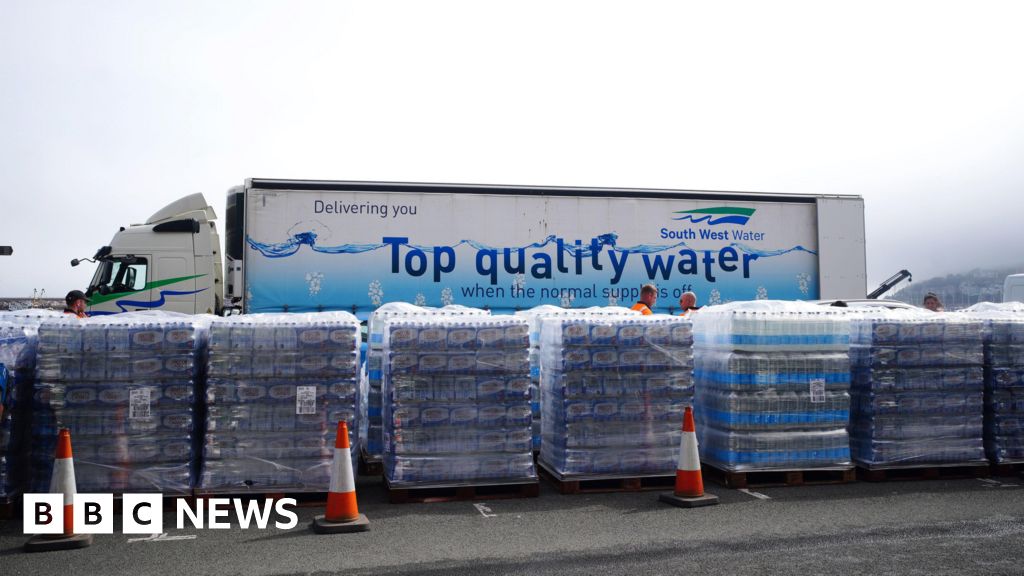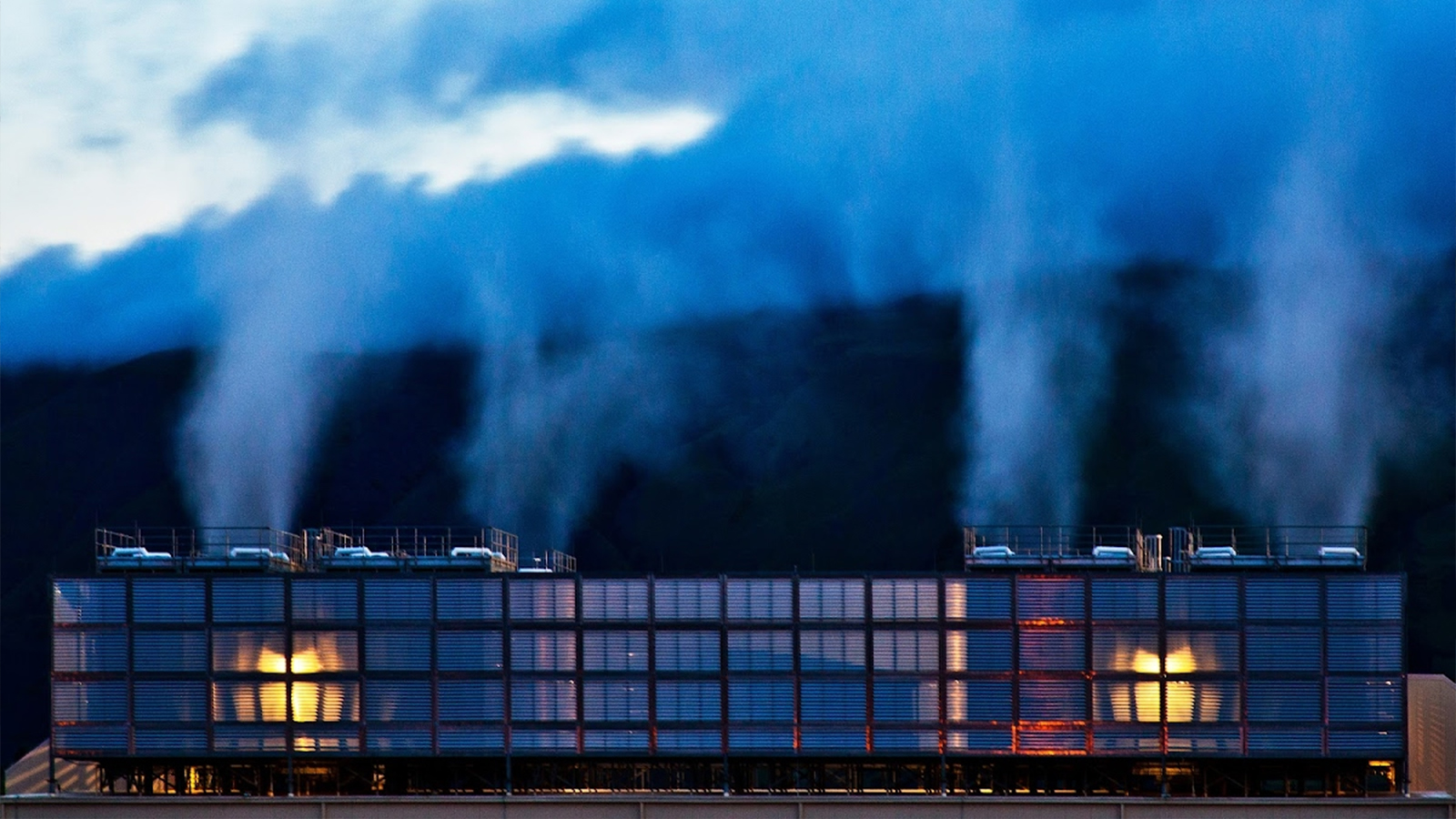Collapse
Because of admin interference with the content https://lemmy.ml/modlog/16033 and disciplinary actions we obviously can't stay here. We've set up shop on http://lemm.ee/c/collapse !collapse@lemm.ee so please update your subscription if you intend to continue to follow this community. At some point this community will be mothballed, unless wabooti@lemmy.ml wants to continue taking care of it.

As suggested in [this post](https://lemmy.ml/post/1208369) we will try out to establish a weekly observations thread. Share whats happening in your hometown, region or country that might not be in the focus of international media! Picture: North Atlantic Sea Surface Temp. Anomaly
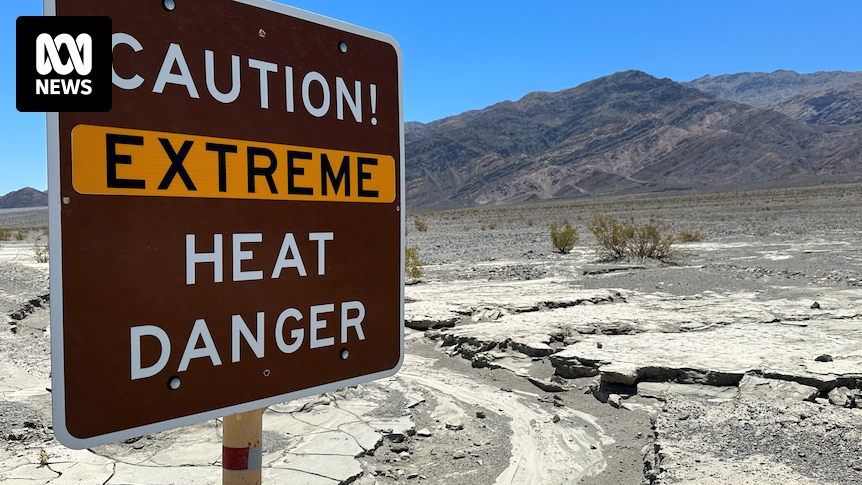 www.abc.net.au
www.abc.net.au
>Climate Central vice-president for science Andrew Pershing said the figures illustrated the "huge burden" the burning of fossil fuels imposed on people around the world >"Australia didn't have a particularly interesting summer this year, but in Africa it's just day after day after day of climate change just beating down on that continent."
 youtube.com
youtube.com
Summary: The video is about the challenges of decarbonizing the world economy and why capitalism is not an effective solution, according to the guest speaker Brett Christophers. Christophers is interviewed by Aaron Bastani on Novara Media. The conversation starts with the confusion around the term "Net Zero." Christophers explains the difference between Net Zero and real zero emissions. Net Zero allows emissions as long as they are offset by carbon capture or sequestration. Christophers argues that governments are not serious about decarbonization because they continue to grant new oil and gas exploration licenses. He also criticizes the over-reliance on future, unproven technologies for capturing carbon emissions. The interview then covers why electrification is critical for mitigating climate change. Christophers explains that most greenhouse gas emissions come from burning fossil fuels to generate electricity. Therefore, decarbonizing the electricity sector is the most important strategy. The conversation then dives into the challenges of transitioning to renewable energy sources. Christophers acknowledges that solar and wind are not perfect solutions because they are intermittent sources of energy. He also discusses the land-use challenges of building large-scale solar and wind farms. Nuclear power is brought up as a potential solution, especially for large companies that need consistent baseload power. Christophers says that governments should incentivize the development of all carbon-free energy sources, including nuclear. The video concludes with Christophers arguing that capitalism is not a solution to the climate crisis because it prioritizes the interests of capital over the well-being of the planet.
cross-posted from: https://slrpnk.net/post/10097890 > > India’s heat waves are attributed to a combination of short-term weather patterns and long-term warming trends fueled by human-caused climate change. Residents in India’s sprawling capital are often particularly affected, because dense buildings, roads, cars and air conditioners contribute to urban heat, experts say. >
cross-posted from: https://lemmy.world/post/15823220 > >### Four parties hammer out agreement filled with bad news for scientists > > ------------- > > >The nationalist, populist Party for Freedom, led by Geert Wilders, won 23% of the vote in the November 2023 House elections, putting Wilders—once a fringe figure who proposed a “head rag tax” on women wearing headscarves—close to the center of power. Since then, Wilders has been in contentious and often chaotic negotiations to form a government with three other parties, including the center-right party led by outgoing Prime Minister Mark Rutte, which saw its electoral share shrink to 15%. The governing plan endorsed by the four parties, which marks a crucial step in forming a new government, includes a series of harsh anti-immigration measures. Centrist and left-wing parties fiercely criticized the plan during this week’s debate. > > -------------- > > >Another sharp turn comes in environmental policy. The Netherlands, a major agricultural exporter, has more farm animals per square kilometer than any other country in Europe, and their waste emits high levels of nitrogen compounds that violate EU rules and harm the country’s ecosystems. Past government plans to tackle the issue have triggered massive protests by farmers and the rise of a new party, the Farmer-Citizen Movement, that won 4.7% of the vote and is part of the new coalition. > >
cross-posted from: https://lemmy.ca/post/21764216 > Aquatic life from coral reefs to fish in the Thailand's eastern gulf coast is suffering as sea surface temperatures hit record highs this month amid a regional heatwave, worrying scientists and local communities. > > The once vibrant and colourful corals, about five metres (16 feet) underwater, have turned white in a phenomenon known as coral bleaching, a sign that their health was deteriorating, due to higher water temperatures, scientists say. > > Sea surface temperatures in the Eastern Gulf of Thailand reached 32.73°C (90.91°F) earlier this month while underwater readings are slightly warmer, with dive computers showing around 33°C, data shows. > > If water temperatures do not cool, more coral will die, Lalita said. > > "It's global boiling, not just global warming," she said.
There may not even be enough vultures to eat our corpses at the end of the world.
Significance Technological innovation is central to sustainable development, but representing novel technologies in systems models is difficult due to limited data on their past performance. We propose a method to model the feasibility space for novel technologies that combines empirical data on historical analogs and early adoption with a global integrated assessment model. Applying this method to direct air carbon capture and storage (DACCS), we find that the feasibility space is large, with DACCS contributing meaningfully to net-zero goals if it grows like some analogs and failing to do so with others. The results can be used to identify technology and policy features that may be important in enabling rapid adoption to avert the worst effects of climate change. Abstract Limiting the rise in global temperature to 1.5 °C will rely, in part, on technologies to remove CO2 from the atmosphere. However, many carbon dioxide removal (CDR) technologies are in the early stages of development, and there is limited data to inform predictions of their future adoption. Here, we present an approach to model adoption of early-stage technologies such as CDR and apply it to direct air carbon capture and storage (DACCS). Our approach combines empirical data on historical technology analogs and early adoption indicators to model a range of feasible growth pathways. We use these pathways as inputs to an integrated assessment model (the Global Change Analysis Model, GCAM) and evaluate their effects under an emissions policy to limit end-of-century temperature change to 1.5 °C. Adoption varies widely across analogs, which share different strategic similarities with DACCS. If DACCS growth mirrors high-growth analogs (e.g., solar photovoltaics), it can reach up to 4.9 GtCO2 removal by midcentury, compared to as low as 0.2 GtCO2 for low-growth analogs (e.g., natural gas pipelines). For these slower growing analogs, unabated fossil fuel generation in 2050 is reduced by 44% compared to high-growth analogs, with implications for energy investments and stranded assets. Residual emissions at the end of the century are also substantially lower (by up to 43% and 34% in transportation and industry) under lower DACCS scenarios. The large variation in growth rates observed for different analogs can also point to policy takeaways for enabling DACCS.
 thereader.mitpress.mit.edu
thereader.mitpress.mit.edu
The interview discusses the potential for civilizational collapse due to climate change and other environmental issues. Watts points out that the solution lies not in technological fixes, but in a fundamental change in human behavior. He argues that the current trajectory of maximizing short-term gains is unsustainable and that a shift towards long-term survival strategies is necessary. Watts further argues that at this point the goal is not to prevent collapse, but to survive it and rebuild in a way that preserves the valuable aspects of our current civilization. To do that we need a shift in perspective towards long-term thinking and a willingness to adapt and change in the face of adversity.
 www.mdpi.com
www.mdpi.com
Abstract Total Solar Irradiance (TSI) quantifies the solar energy received by the Earth and therefore is of direct relevance for a possible solar influence on climate change on Earth. We analyse the TSI space measurements from 1991 to 2021, and we derive a regression model that reproduces the measured daily TSI variations with a Root Mean Square Error (RMSE) of 0.17 W/m2. The daily TSI regression model uses the MgII core to wing ratio as a facular brightening proxy and the Photometric Sunspot Index (PSI) as a measure of sunspot darkening. We reconstruct the annual mean TSI backwards to 1700 based on the Sunspot Number (SN), calibrated on the space measurements with an RMSE of 0.086 W/m2. The analysis of the 11 year running mean TSI reconstruction confirms the existence of a 105 year Gleissberg cycle. The TSI level of the current grand minimum is only about 0.15 W/m2 higher than the TSI level of the grand minimum in the beginning of the 18th century. Keywords: total solar irradiance; sunspot number
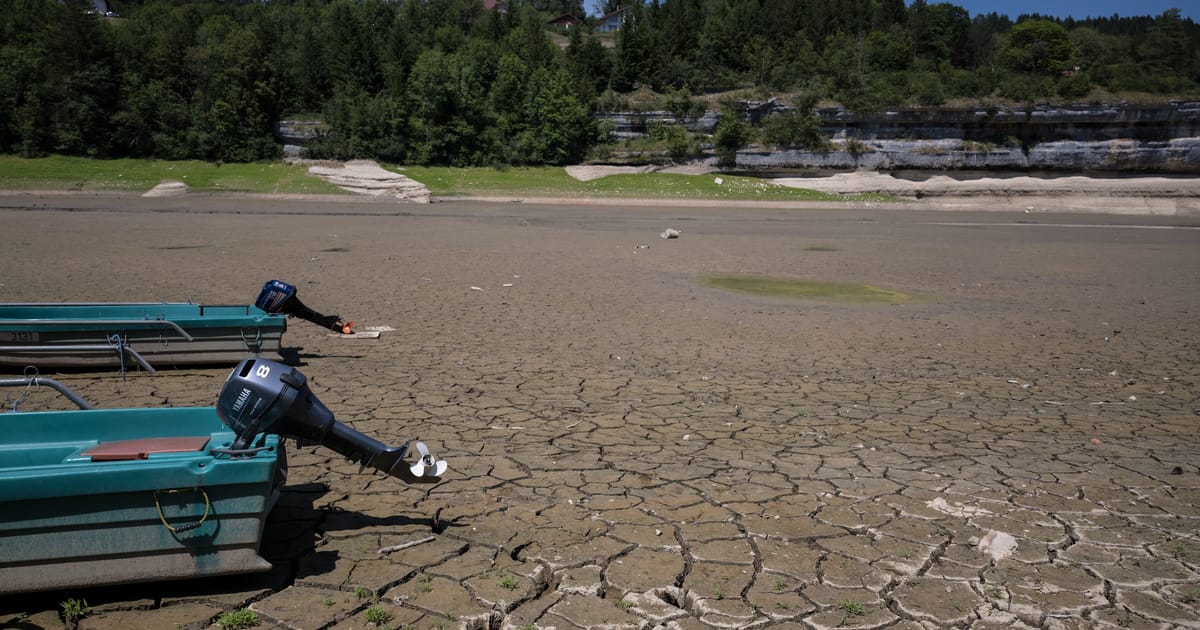 www.politico.eu
www.politico.eu
cross-posted from: https://lemmy.world/post/15351530 > _Water-rich Switzerland controls Western Europe’s taps — and wants it to stay that way. Its drought-ridden neighbors are getting nervous._ > > At the western edge of **Lake Geneva**, where the mighty **Rhône river squeezes through a narrow dam, a blunder of French diplomacy is carved into stone for all to see**. > > The inscription, mounted on the walls of an old industrial building, commemorates the 1884 accord between three Swiss cantons that have regulated the water levels of this vast Alpine lake ever since. It does not mention France — even though some 40 percent of the lake is French territory. > > “France, for some reason, wasn’t part of the contract,” said Jérôme Barras as he unlocked a gate below the epigraph to inspect a hydropower plant under the dam he has managed for more than a decade. > > When the agreement was renewed and a new dam was built a century later, Paris still wasn’t interested. > > The French government now regrets that. > > … > > **And France has suddenly realized it can’t control that tap as it battles water shortages, destructive droughts and baking heat**.
 www.nature.com
www.nature.com
Abstract Stratocumulus clouds cover 20% of the low-latitude oceans and are especially prevalent in the subtropics. They cool the Earth by shading large portions of its surface from sunlight. However, as their dynamical scales are too small to be resolvable in global climate models, predictions of their response to greenhouse warming have remained uncertain. Here we report how stratocumulus decks respond to greenhouse warming in large-eddy simulations that explicitly resolve cloud dynamics in a representative subtropical region. In the simulations, stratocumulus decks become unstable and break up into scattered clouds when CO2 levels rise above 1,200 ppm. In addition to the warming from rising CO2 levels, this instability triggers a surface warming of about 8 K globally and 10 K in the subtropics. Once the stratocumulus decks have broken up, they only re-form once CO2 concentrations drop substantially below the level at which the instability first occurred. Climate transitions that arise from this instability may have contributed importantly to hothouse climates and abrupt climate changes in the geological past. Such transitions to a much warmer climate may also occur in the future if CO2 levels continue to rise.
Abstract and Figures Rapid warming in the Arctic has the potential to release vast reservoirs of carbon into the atmosphere as methane (CH4) resulting in a strong positive climate feedback. This raises the concern that, after a period of near-zero growth in atmospheric CH4 burden from 1999 to 2006, the increase since then may be in part related to increased Arctic emissions. Measurements of CH4 in background air samples provide useful, direct information to determine if Arctic CH4 emissions are increasing. One sensitive first-order indicator for large emission change is the Interpolar Difference, that is the difference in surface atmospheric annual means between polar northern and southern zones (53°–90°), which has varied interannually, but did not increase from 1992 to 2019. The Interpolar Difference has increased moderately during 2020–2022 when the global CH4 burden increased significantly, but not yet to its peak values in the late-1980s. For quantitative assessment of changing Arctic CH4 emissions, the atmospheric measurements must be combined with an atmospheric tracer transport model. Based on multiple studies including some using CH4 isotopes, it is clear that most of the increase in global atmospheric CH4 burden is driven by increased emissions from microbial sources in the tropics, and that Arctic emissions have not increased significantly since the beginning of our measurement record in 1983 through 2022.
 www.nature.com
www.nature.com
Abstract The Paleocene–Eocene Thermal Maximum (PETM) was a period of geologically-rapid carbon release and global warming ~56 million years ago. Although modelling, outcrop and proxy records suggest volcanic carbon release occurred, it has not yet been possible to identify the PETM trigger, or if multiple reservoirs of carbon were involved. Here we report elevated levels of mercury relative to organic carbon—a proxy for volcanism—directly preceding and within the early PETM from two North Sea sedimentary cores, signifying pulsed volcanism from the North Atlantic Igneous Province likely provided the trigger and subsequently sustained elevated CO2. However, the PETM onset coincides with a mercury low, suggesting at least one other carbon reservoir released significant greenhouse gases in response to initial warming. Our results support the existence of ‘tipping points’ in the Earth system, which can trigger release of additional carbon reservoirs and drive Earth’s climate into a hotter state.
 www.theguardian.com
www.theguardian.com
>Dr Henri Waisman, at the IDDRI policy research institute in France, said: “Climate change is not a black or white question and every tenth of a degree matters a lot, especially when you look at the socioeconomic impacts. This means it is still useful to continue the fight.” and while I agree with the sentiment, we really aren't "fighting" are we, quite the opposite. Every thing we're doing is wrong, how do we know this ? CO~2~ppm is still increasing, fossil fuel use increased in 2023, planes are still droning overhead, cars still driving, more roads being built and winded, the Antarctic is being stripped of krill to make pet food etc
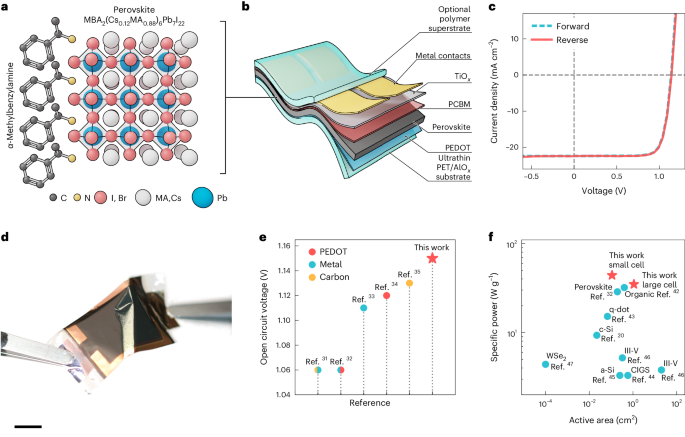 www.nature.com
www.nature.com
Abstract Perovskite solar cells are a promising technology for emerging photovoltaic applications that require mechanical compliance and high specific power. However, the devices suffer from poor operational stability. Here we develop lightweight, thin (<2.5 μm), flexible and transparent-conductive-oxide-free quasi-two-dimensional perovskite solar cells by incorporating alpha-methylbenzyl ammonium iodide into the photoactive perovskite layer. We fabricate the devices directly on an ultrathin polymer foil coated with an alumina barrier layer to ensure environmental and mechanical stability without compromising weight and flexibility. We demonstrate a champion specific power of 44 W g−1 (average: 41 W g−1), an open-circuit voltage of 1.15 V and a champion efficiency of 20.1% (average: 18.1%). To show scalability, we fabricate a photovoltaic module consisting of 24 interconnected 1 cm2 solar cells and demonstrate energy-autonomous operation of a hybrid solar-powered quadcopter, while constituting only 1/400 of the drone’s weight. Our performance and stability demonstration of ultra-lightweight perovskite solar cells highlight their potential as portable and cost-effective sustainable energy harvesting devices.
Structured Abstract INTRODUCTION Anthropogenic carbon dioxide (CO2) emissions have driven an increase in the global atmospheric CO2 concentration from 280 parts per million (ppm) before industrialization to an annual average of 419 ppm in 2022, corresponding to an increase in global mean surface temperature (GMST) of 1.1°C over the same period. If global CO2 emissions continue to rise, atmospheric CO2 could exceed 800 ppm by the year 2100. This begs the question of where our climate is headed. The geologic record is replete with both brief and extended intervals of CO2 concentration higher than today and thus provides opportunities to project the response of the future climate system to increasing CO2. For example, it has been estimated that global surface temperature 50 million years ago (Ma) was ~12°C higher than today, in tandem with atmospheric CO2 concentrations some 500 ppm higher (i.e., more than doubled) than present-day values. Consistent with these estimates, Antarctica and Greenland were free of ice at that time. However, reconstructing these values prior to direct instrumental measurements requires the use of paleoproxies—measurable properties of geological archives that are closely, but only indirectly, related to the parameter in question (e.g., temperature, CO2). To date, at least eight different proxies from both terrestrial and marine archives have been developed and applied to reconstruct paleo-CO2, but their underlying assumptions have been revised over time, and published reconstructions are not always consistent. This uncertainty complicates quantification of the climate responses to the ongoing rise of atmospheric CO2 concentrations.








